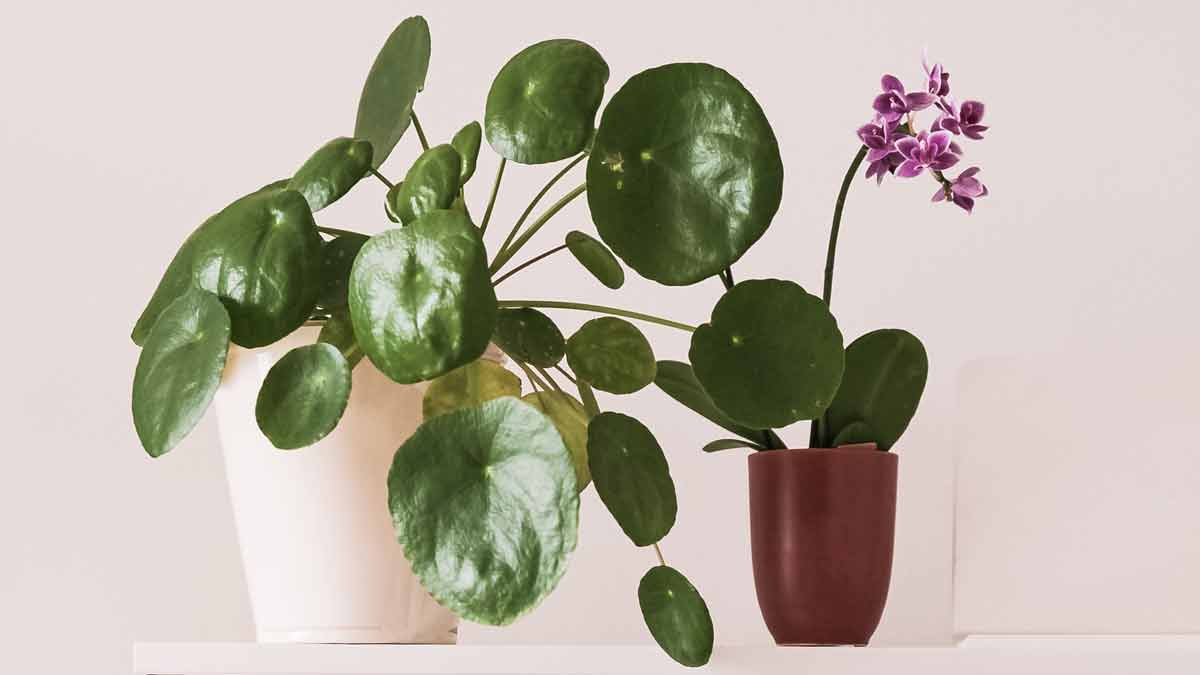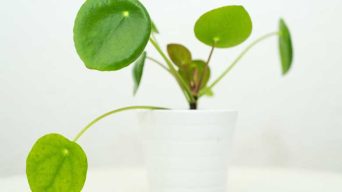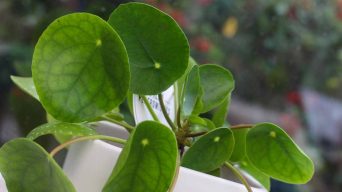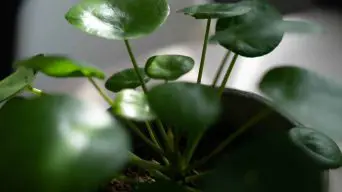The Pilea plant, also known as the Money plant, is known for being relatively low-maintenance, but it still need proper care to stay healthy.
One of the most common problems that can affect a Pilea is underwatering.
Having an underwatered Pilea is not necessarily a death sentence for the plant, but it can lead to several health problems if left untreated.
Here’s what you need to know about underwatering a Pilea, how to identify it, and what you can do to fix the problem.
What is Underwatering?
Underwatering is one of the most common problems that houseplants face.
It occurs when a plant does not receive enough water to meet its needs.
This can happen for several reasons, including forgetting to water the plant or when the roots cannot absorb water properly.
What Are the Risks of Underwatering a Pilea
While underwatering is a common problem, it can lead to several severe problems for your Pilea.
Water is essential for plants because it helps them:
- Transport nutrients and minerals from the soil to the rest of the plant.
- Stay cool and regulate their temperature.
- Maintain a strong structure.
- Helps create energy and food for the plant through photosynthesis.
When a plant does not have enough water, it can experience several problems.
In severe cases, the plant may become susceptible to pests and diseases, stop growing, and eventually die.
How Does Underwatering a Pilea Plant Occur
There are several reasons why an underwatered Pilea may occur.
Some of the most common include:
Not Enough Water
One of the main reasons why an underwatered Pilea may occur is simply because the plant isn’t being watered enough.
This is often due to forgetfulness on the part of the gardener or owner but can also be caused by several other factors such as busy schedules or plants that are difficult to reach.
Improper Drainage
Another common reason for an underwatered Pilea is improper drainage.
If the pot or container that the plant is in does not have proper drainage holes, the roots will become waterlogged and begin to rot.
Rotten roots cannot absorb water or nutrients properly, leading to an underwatered plant.
Not the Right Soil
The type of potting soil that a Pilea is planted in can also affect how well the plant absorbs water.
Soils that are too dense or compacted will not allow water to penetrate the roots, resulting in an underwatered plant.
It’s essential to use a light and airy potting mix with good drainage to prevent this from happening.
Hot Weather
Hot weather can also cause an underwatered Pilea.
During periods of high heat, the plant will transpire more water than usual which can quickly lead to dehydration if it’s not watered enough.
During the hottest months, it’s essential to be extra vigilant about watering your Pilea plants to prevent them from becoming underwatered.
Not Enough Humidity
Pilea plants come from tropical regions and prefer high humidity environments.
If the air around your indoor plant is too dry, it will cause the plant to lose water faster than it can take it in, leading to an underwatered state.
To prevent this, mist your plant regularly or place it on a pebble tray to increase the humidity around it.
Too Much Sunlight
While Pilea plants prefer bright indirect light, too much sun can cause them to become underwatered.
The plant will transpire more water to cool itself down, leading to dehydration if it’s not being watered enough.
If you think your plant is getting too much direct sunlight, move it to a shadier spot.
Root-Bound Plants
Pilea plants that are root-bound (or pot-bound) are also more likely to become underwater.
This is because the roots have nowhere else to go but to circle around the edge of the pot, leading to poor absorption of water and nutrients.
If your plant is root-bound, you’ll need to repot it into a larger container.
Pest Damage
Pests can also cause an underwatered Pilea.
If the plant is infested with aphids, scale, or mealybugs, they will suck the moisture out of the leaves, which can lead to dehydration.
To prevent this, regularly inspect your plant for pests and treat them accordingly if found.
Diseases
Certain diseases can also cause an underwatered Pilea.
Fungal diseases such as root rot and leaf spot can kill the roots or leaves of the plant, preventing it from taking in water and leading to dehydration.
To prevent this, ensure to only water your plant with clean water and avoid overwatering your Pilea plant.
How To Tell If Your Pilea Is Underwatered
Catching an underwatered Pilea early is essential so it can be adequately watered and revived.
That’s why it’s essential to know the signs of an underwatered plant.
Signs of an Underwatered Pilea
There are a few tell-tale signs that your Pilea is underwatered:
Drooping Leaves
The first and most obvious sign of an underwatered Pilea is drooping leaves.
When a plant doesn’t have enough water, it cannot support its leaves’ weight, causing them to droop down.
Seeing your Pilea leaves drooping signifies the plant is thirsty and must be watered immediately.
Wrinkled or Curling Leaves
Another common sign of an underwatered Pilea is wrinkled or curled leaves.
This is caused by the plant losing water faster than it can take it in, causing the Pilea leaves to curl or wrinkle.
If you see this happening to your Pilea, water it immediately.
Leaves Turning Yellow or Brown
Insufficient watering is often indicated by brown or yellow leaves in Pilea plants.
When a plant doesn’t have enough water, the plant will not be able to transport nutrients to the leaves, causing the Pilea leaves to turn yellow or brown and eventually die.
If you see this happening to your Pilea, water it immediately and check for other signs of stress, such as pests or diseases.
Brown Spots on the Leaves
Brown spots on the leaves can also be a sign of an underwatered Pilea.
These brown spots are caused by the plant losing water faster than it can take it in, causing the leaves to dehydrate and die.
If you see this happening to your Pilea, water it immediately.
Brown Leaf Tips or Edges
If you see brown leaf tips or edges on your Pilea, it’s a sign that the plant is not getting enough water.
When a plant doesn’t have enough water, the Pilea leaves will start to dehydrate, and one of the first places you’ll see it is at the tips or edges of the leaves.
If you see this happening to your Pilea, water it immediately.
Leaf Drop
If you see your Pilea plant leaves falling off, it’s a sign that it is not getting enough water.
When a plant doesn’t have enough water, it will start to shed leaves because it can’t support the weight of the leaves.
If you see this happening to your Pilea, water it immediately.t
Dry or Cracked Soil
Another sign of an underwatered Pilea is dry or cracked soil.
When the potting soil has been dry for too long, it will start to crack and pull away from the sides of the pot.
If you see this happening to your Pilea, water it immediately.
Slow Growth
If you see that your Pilea’s growth has slowed down, it’s a sign that the plant is not getting enough water.
When a plant doesn’t have enough water, it will not be able to grow as quickly as it usually would.
If you see this happening to your Pilea, water it immediately.
How To Save an Underwatered Pilea?
If you think your Pilea is underwatered, there are a few things you can do to save it.
Here are a few tips on how to save an underwatered Pilea:
1. Water Deeply and Thoroughly
If you think your Pilea is underwatered, you must first water it deeply and thoroughly.
Ensure to water the plant until the water starts coming out of the drainage holes at the bottom of the pot.
This will ensure that the plant is getting enough water.
2. Move the Plant to a Humid Environment
If you think your Pilea is underwatered, you can also try moving the plant to a more humid environment.
This will help the plant rehydrate and recover from the stress of being underwater.
3. Mist the Plant
You can also try misting the plant if your Pilea is underwatered.
Misting the plant will help increase the humidity around the plant and will help the plant rehydrate.
4. Use a Humidity Tray
If you think your Pilea is underwatered, try using a humidity tray.
A humidity tray is a tray of water that you place under your plant’s pot.
The water will evaporate and increase the humidity around the plant, which will help the plant rehydrate.
5. Give a Good Soak
If you think your Pilea is underwatered, try giving it a good soak.
To do this, you must water the plant deeply and then let the plant sit in the water for a few hours.
This will help the plant rehydrate and recover from the stress of being underwater.
6. Repot the Plant
If your Pilea is underwatered, you can also try repotting the plant.
When a plant is in a pot that is too small, the roots can become bound and become stressed.
Repotting the plant will help the roots breathe and will help the plant recover from the stress of being underwater.
7. Be Patient
If you think your Pilea is underwatered, the most important thing you can do is be patient.
It can take a while for a plant to recover from being underwater, so don’t give up hope.
With time and care, your plant will recover and be healthy again.
How To Prevent an Underwatered Pilea
If you want to prevent your Pilea from becoming underwatered, you can do a few things.
Here are a few tips on how to prevent underwatered Pilea:
1. Water Regularly and Deeply
Make sure to water your Pilea regularly and deeply.
Water the plant until the water starts to come out of the drainage holes at the bottom of the pot.
This will ensure that the plant is getting enough water.
2. Use a Moisture Meter
A moisture meter is a tool you can use to measure the moisture in your plant’s soil.
Using a moisture meter will help you to know how often to water a Pilea plant and will help you to prevent underwatered Pilea.
3. Use the Right Size Pot
Make sure to use a pot that is the right size for your Pilea.
If the pot is too big, the plant will likely become underwatered.
On the other hand, if the pot is too small, the plant may become root-bound and unable to get enough water.
4. Use the Right Soil
Make sure to use a light, well-draining potting soil for your Pilea.
A potting mix that is too heavy will not allow the roots to breathe, making it more difficult for the plant to get the water it needs.
5. Place Your Pilea in the Right Location
Place your Pilea where it will get the right amount of light.
If the plant gets too much or too little light, it may become stressed and more likely to become underwater.
6. Monitor the Weather
Make sure to monitor the weather conditions in your area.
If the weather is very hot or dry, you may need to water your Pilea more often to prevent it from becoming underwatered.
On the other hand, if the weather is cool or wet, you may need to water your Pilea less often.
7. Be Careful When Fertilizing
Be careful not to overfertilize your Pilea.
If you fertilize the plant too often, it will become stressed and more likely to become underwater.
It is best to fertilize your Pilea every two weeks during the growing season and to use a half-strength fertilizer solution.
8. Check the Soil Regularly
Make sure to check the soil of your Pilea regularly.
Feel the soil with your fingers to see if it is dry.
If the soil is dry, it is time to water the plant.
9. Mulch the Soil
Mulching the soil around your Pilea will help preserve moisture in the soil and prevent the plant from becoming underwater.
10. Be Careful When Transplanting
Be careful not to damage the roots of your Pilea when transplanting.
Transplanting can stress the plant and make it more likely to become underwater.
When transplanting, be careful not to damage the roots as this can stress the plant and make it more likely to become underwater.
It is best to transplant your Pilea in the spring or fall when the plant is not actively growing.
11. Group Plants Together
Grouping plants together can help to create a microclimate that will help to prevent the plants from becoming underwatered.
When plants are grouped together, they can help to shade the soil and protect it from direct sun.
They can also help to trap moisture in the air and create a more humid environment around the plants.
12. Use Watering Trays
Using watering trays can help to water your plants more evenly and can help to prevent the plants from becoming underwatered.
Watering trays help to make sure that each plant is getting the same amount of water.
13. Check for Pests
Make sure to check your plant for pests regularly.
Pests can damage your plant’s roots and make it more likely to become underwater.
If you find pests on your plant, make sure to treat them right away.
14. Check for Diseases
Make sure to check your plant for diseases regularly.
Diseases can damage your plant’s roots and make it more likely to become underwater.
If you find diseases on your plant, make sure to treat them right away.
15. Check for Root Rot
Make sure to check your plant for root rot regularly.
Root rot is a serious disease that can damage your plant’s roots and make it more likely to become underwater.
If you find root rot on your Pilea plant, make sure to treat it right away.
Final Thoughts
Pilea care can be easy once you get the hang of it, but even experienced plant parents can find themselves with an underwatered Pilea.
The key to success is paying close attention to your plant and getting to know its watering needs.
If you think your Pilea is underwatered, look closely at the leaves and soil. If the leaves are drooping or the soil is dry, it’s time to give your plant a drink.
Use filtered water and let the plant soak up as much as it needs.
If you regularly find yourself with an underwatered Pilea, take a close look at your watering habits and ensure you’re not overwatering.
Overwatering is just as harmful to plants as underwatering, so finding a happy medium is essential.
With a bit of care and attention, your Pilea will be thriving in no time!







